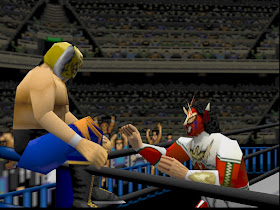The effect works ok in LLE
The games are: Armorines - Project S.W.A.R.M., South Park, Turok 2 - Seeds of Evil, Turok 3 - Shadow of Oblivion. All these games were released by Acclaim Entertainment Inc. This is suspicious coincidence. We found that all four games use the same ucode. String id of the ucode claimed that it is standard modification of F3DEX2. Analysis of lighting related commands showed that lighting method used by this ucode is not standard at all, but we did not find any documents, which could explain how it works.
The only way in this case is reverse engineering of ucode's assembler code. olivieryuyu, after success with decoding T3DUX ucode, decided to solve that mystery. He found, that the lighting part of the ucode has custom code indeed. That custom code activated only in special places in games, exactly where highlighting effect is missing.
Standard N64 lighting uses directional and ambient lights. Directional light has direction (vector with 8bit coordinates) and color. Ambient light has only color. Vertex color calculated as sum of colors of directional lights multiplied by light intensity plus color of ambient light. Light intensity depends on angle between light direction and normal to surface, which is kept in vertex.
Custom lighting method, which I called Acclaim lighting, works absolutely differently. Light structure contains position of light source in space (three 16bit coordinates), tree additional 16bit parameters and light's color. 16 bytes in total. Standard light structure has 12 bytes. Eight 16-bytes light structures loaded once at the beginning of display list, when highlight effect used. At first sight these structures have no relation to further rendering process. Game objects use the same vertices, which have the same colors. Lighting bit in geometry mode is switched off. Standard vertex processing method works as if no lighting is used, thus no highlighting effect.
olivieryuyu found geometry mode bit, which activates Acclaim lighting and decoded calculations used by this method. How it works:
- For each light source calculate vector from light source position to vertex.
- Calculate sum of absolute values of vector's x y and z coordinates.
- If this sum is greater than some parameter (say A) in the light source structure, this light is ignored.
- Light intensity is calculated as abs(sum - A) * B, where B is another parameter in the light source structure.
- Light color is multiplied by light intensity and added to vertex color.
- Final result is clamped to 1.
Thus, vertex color brightness can be increased, depending on vertex position. The algorithm looks like an approximation of point lighting. Standard point lighting uses length of vector from vertex to light source to calculate light intensity. Vector length is square root of sum of squares of vector coordinates. This method uses plain sum of vector coordinates.
I implemented Acclaim lighting in GLideN64. The problem is finally solved.
Side by side comparison video
- PayPal: https://www.paypal.me/SergeyLipskiy
- Yandex money: banner atop.









